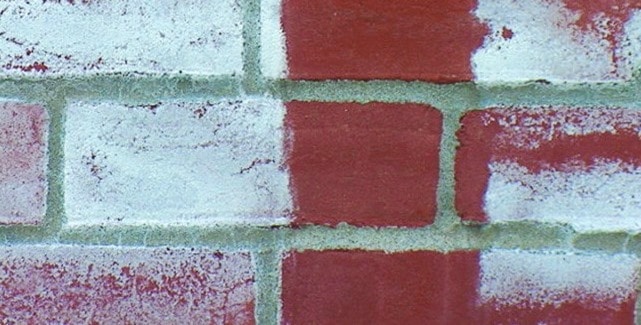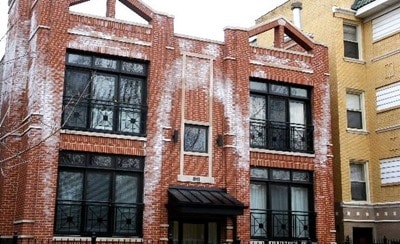What is Efflorescence on Brick Masonry, Its Causes and Treatment Techniques?
What is Efflorescence on Brick Masonry?
Efflorescence on brick masonry is a white and sometimes brown green or yellow powdery substance observed in winter season. It is produced as result of mixing soluble salts and water.
The salt would deposit on brick masonry and manifest itself as efflorescence after water evaporates. The color of the efflorescence is based on the type of salt that creates it.
Efflorescence might disappear in summer occasionally but it frequently remains through the year. Figure-3 shows efflorescence on masonry wall.

Fig.1: Efflorescence on Brick Masonry Wall
Following topics regarding efflorescence on brick masonry are discussed:
- What are the causes of efflorescence?
- Factors that affect efflorescence
- What the sources of materials that causes efflorescence?
- What are the detrimental effects on efflorescence on brick masonry building?
- What are the methods used to tackle efflorescence of brick masonry?
- How to control efflorescence on brick masonry?
- How to remove efflorescence on brick masonry?

Fig.1: Efflorescence on brick masonry wall

Fig.2: Efflorescence on brick masonry structure
What are the Causes of Efflorescence?
The condition in which efflorescence occurs is unique and all conditions should be met otherwise brick masonry would not suffer from it.
There are three main conditions that offer excellent condition for efflorescence formation on brick masonry wall. The conditions are explained in the following section:
- Masonry brick wall should contain soluble salts and the salt might be in masonry brick, mortar, adjacent soil and backing material
- Water should present in brick masonry wall and need to be in contact with soluble salt to dissolve it.
- Brick masonry wall shall possess pore structure to permit the migration of soluble salt to the surface where water may evaporate and leave the salt.
- These conditions should be present for the efflorescence to occur.
Factors Affecting Efflorescence on Bricks
- Temperature: high temperature decreases efflorescence possibility since it evaporates water prior to reaching brick masonry surface.
In contrary, efflorescence formation is frequent in water because water would have enough time to reach brick masonry surface
- Wind
- Humidity
What the Sources of Materials Causing Efflorescence?
In the above discussion, materials causing the occurrence of efflorescence on brick masonry wall is discussed.
It is considerably important to specify their sources because it might help the decrease of efflorescence through control material sources.
The sources materials namely soluble salt and water are explained below:
Source of Soluble Salt on Brick Masonry
There are several sources of salts for instance brick masonry, block masonry, mortar constituents including cement, sand, lime and admixture, grout components involve cement, sand, aggregates and admixtures, contacting soil and ground water.
It should be known that salts may be produced because of reactions between different constituents of brick masonry walls. All soluble salts are capable of producing efflorescence, for instance, carbonates silicate, sulfate, and chloride.
It is worth mentioning that efflorescence produced by chloride might be washed away by water because chloride is substantially soluble in water.
Source of Moisture on Brick Masonry
The major source of moisture is rain water specifically wind driven rain water that lead to penetrate considerable water quantity into the wall. Leakage of moist air from the interior of the structure is another source of moisture in brick masonry wall.
What are the Detrimental Effects of Efflorescence on Brick Masonry Building?
Generally, efflorescence does not lead to structural deterioration of brick masonry. However, it distorts aesthetic view of the structure and if the problem maintain for long time, it would be required to investigate and tackle the source of moisture to prevent efflorescence formation.
It should be known that, efflorescence could be generated in short time after construction completion and the term used for this case is bloom efflorescence. The bloom efflorescence is formed few months after the completion of masonry building construction and it would not last for long time.
Therefore, it would not be necessary to take any action in this case because bloom efflorescence is washed away by rain water. Apart from bloom efflorescence, it would be required to investigate the problem and cut the moisture source to prevent the formation of efflorescence.
How to Control Efflorescence on Brick Masonry?
As discussed previously, efflorescence is occurred if three aforementioned conditions are met. However, when these conditions are controlled then the efflorescence can be avoided.
- Decline soluble salts
- Design and construct masonry structure properly to prevent water penetration
- Execute construction suitably to avoid paths through which moisture travels
It should be remembered that, efflorescence cannot be eliminated completely. That is why the next section will be about the removal of efflorescence.
How to Remove Efflorescence on Brick Masonry?
Inevitably, efflorescence is formed on the surface of brick masonry wall due to natural or manmade reasons. The removal of efflorescence is conducted using one of the following methods:
- Dry brush
- Rinsing with water or other acceptable liquid
- Hand washing
- Sand blasting
- Utilize special chemical cleaner
- Ordinary chemical cleaner such as muriatic
There are number of factor that controls the selection of efflorescence removal. For example, if the salt is soluble, it is recommended to apply dry brush. Hand washing is recommended to choose for small efflorescence batches.
It should be known that the removal and cleaning of the efflorescence on masonry surface would not solve the problem. So, it is required to seal the wall to tackle the problem permanently.
References
Efflorescence: That Annoying White Powder On Masonry Walls. Keller Engineering. Ottawa , p. 1-3. 2014.
HAROLD B. NEWMAN for Water Soluble Deposits to Form on Masonry Surfaces, There must be a source of salt and water to move the salt Hanley-Wood, LLC. [S.l.], p. 1-4. 2000.
JEFFREY L. ELDER, S.E., LEED AP. Efflorescence, Can it be Controlled? Western States Clay Products Association. [S.l.], p. 1-5.
KENNETH A. HOOKER. Reducing Efflorescence Potential: Understand how efflorescence occurs, select materials to minimize soluble salts, and detail to control water penetration. The Aberdeen Group. Aberdeen , p. 1-2. 1994.
MIA. Efflorescence: Cause and Control. Masonry Institute of America. Torrance, p. 1-4. 2014.
Comments